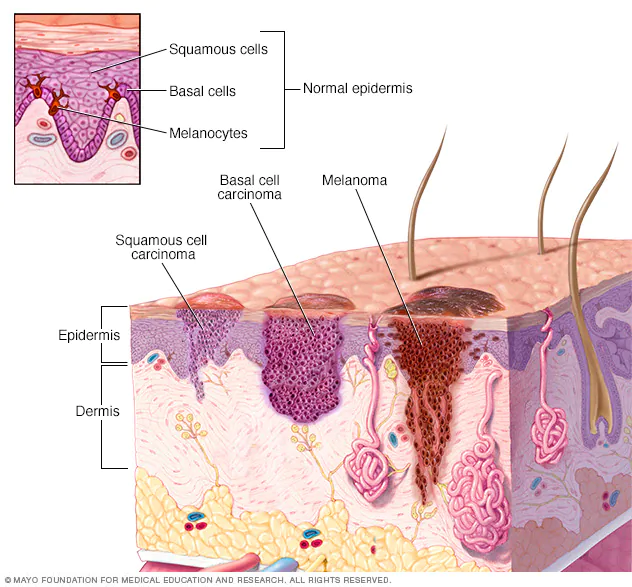Squamous cell carcinoma of the skin is a common form of skin cancer that develops in the squamous cells that make up the middle and outer layers of the skin.
Squamous cell carcinoma of the skin is usually not life-threatening, though it can be aggressive. Untreated, squamous cell carcinoma of the skin can grow large or spread to other parts of your body, causing serious complications.
Most squamous cell carcinomas of the skin result from prolonged exposure to ultraviolet (UV) radiation, either from sunlight or from tanning beds or lamps. Avoiding UV light helps reduce your risk of squamous cell carcinoma of the skin and other forms of skin cancer.
Squamous cells are found in many places in your body, and squamous cell carcinoma can occur anywhere squamous cells are found. Squamous cell carcinoma of the skin refers to cancer that forms in the squamous cells found in the skin.
Symptoms
Squamous cell carcinoma of the skin most often occurs on sun-exposed skin, such as your scalp, the backs of your hands, your ears or your lips. But it can occur anywhere on your body, including inside your mouth, the bottoms of your feet and on your genitals.
Signs and symptoms of squamous cell carcinoma of the skin include:
- A firm, red nodule
- A flat sore with a scaly crust
- A new sore or raised area on an old scar or ulcer
- A rough, scaly patch on your lip that may evolve to an open sore
- A red sore or rough patch inside your mouth
- A red, raised patch or wartlike sore on or in the anus or on your genitals
When to see a doctor
Make an appointment with your doctor if you have a sore or scab that doesn’t heal in about two months or a flat patch of scaly skin that won’t go away.
Causes
Squamous cell carcinoma of the skin occurs when the flat, thin squamous cells in the middle and outer layers of your skin develop changes (mutations) in their DNA. A cell’s DNA contains the instructions that tell a cell what to do. The mutations tell the squamous cells to grow out of control and to continue living when normal cells would die.
Most of the DNA mutations in skin cells are caused by ultraviolet (UV) radiation found in sunlight and in commercial tanning lamps and tanning beds.
But sun exposure doesn’t explain skin cancers that develop on skin not ordinarily exposed to sunlight. This indicates that other factors may contribute to your risk of skin cancer, such as having a condition that weakens your immune system.
Risk factors
Factors that may increase your risk of squamous cell carcinoma of the skin include:
- Fair skin. Anyone, regardless of skin color, can get squamous cell carcinoma of the skin. However, having less pigment (melanin) in your skin provides less protection from damaging UV radiation.
If you have blond or red hair and light-colored eyes and you freckle or sunburn easily, you’re much more likely to develop skin cancer, including squamous cell carcinoma, than is a person with darker skin.
- Excessive sun exposure. Being exposed to UV light from the sun increases your risk of squamous cell carcinoma of the skin. Spending lots of time in the sun — particularly if you don’t cover your skin with clothing or sunblock — increases your risk of squamous cell carcinoma of the skin even more.
- Use of tanning beds. People who use indoor tanning beds have an increased risk of squamous cell carcinoma of the skin.
- A history of sunburns. Having had one or more blistering sunburns as a child or teenager increases your risk of developing squamous cell carcinoma of the skin as an adult. Sunburns in adulthood also are a risk factor.
- A personal history of precancerous skin lesions. Having a precancerous skin lesion, such as actinic keratosis or Bowen’s disease, increases your risk of squamous cell carcinoma of the skin.
- A personal history of skin cancer. If you’ve had squamous cell carcinoma of the skin once, you’re much more likely to develop it again.
- Weakened immune system. People with weakened immune systems have an increased risk of skin cancer. This includes people who have leukemia or lymphoma and those who take medications that suppress the immune system, such as those who have undergone organ transplants.
- Rare genetic disorder. People with xeroderma pigmentosum, which causes an extreme sensitivity to sunlight, have a greatly increased risk of developing skin cancer.
Complications
Untreated squamous cell carcinoma of the skin can destroy nearby healthy tissue, spread to the lymph nodes or other organs, and may be fatal, although this is uncommon.
The risk of aggressive squamous cell carcinoma of the skin may be increased in cases where the cancer:
- Is particularly large or deep
- Involves the mucous membranes, such as the lips
- Occurs in a person with a weakened immune system, such as someone who takes anti-rejection medications after an organ transplant or someone who has chronic leukemia
Prevention
Most squamous cell carcinomas of the skin can be prevented. To protect yourself:
- Avoid the sun during the middle of the day. For many people in North America, the sun’s rays are strongest between about 10 a.m. and 3 p.m. Schedule outdoor activities for other times of the day, even during winter or when the sky is cloudy.
- Wear sunscreen year-round. Use a broad-spectrum sunscreen with an SPF of at least 30, even on cloudy days. Apply sunscreen generously, and reapply every two hours — or more often if you’re swimming or perspiring.
- Wear protective clothing. Cover your skin with dark, tightly woven clothing that covers your arms and legs, and a broad-brimmed hat, which provides more protection than does a baseball cap or visor.
Some companies also sell protective clothing. A dermatologist can recommend an appropriate brand. Don’t forget sunglasses. Look for those that block both types of UV radiation — UVA and UVB rays.
- Avoid tanning beds. Tanning beds emit UV rays and can increase your risk of skin cancer.
- Check your skin regularly and report changes to your doctor. Examine your skin often for new skin growths or changes in existing moles, freckles, bumps and birthmarks. With the help of mirrors, check your face, neck, ears and scalp.
Examine your chest and trunk and the tops and undersides of your arms and hands. Examine both the front and back of your legs and your feet, including the soles and the spaces between your toes. Also check your genital area and between your buttocks.
The list of some Squamous Cell Cancer medicine:



